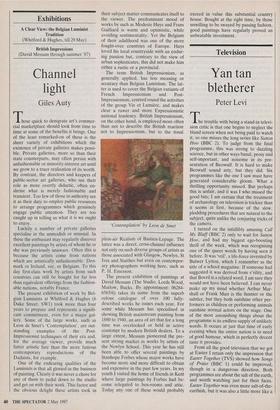Exhibitions
A Clear View: the Belgian Luminist Tradition (Whitford & Hughes, till 29 May) British Impressions (David Messum through summer '87)
Channel light
Giles Auty
Those quick to denigrate art's commer- cial marketplace should look from time to time at some of the benefits it brings. One of the least remarked-on of these is the sheer variety of exhibitions which the existence of private galleries makes possi- ble. Private galleries, more so than their state counterparts, may often persist with unfashionable or minority-interest art until we grow to a truer realisation of its worth. By contrast, the directors and keepers of public-sector art galleries, who see their role as more overtly didactic, often en- shrine what is merely fashionable and transient. Too few of those in authority see it as their duty to employ public resources to arrange programmes which genuinely engage public attention. They are too caught up in telling us what it is we ought to enjoy.
Luckily a number of private galleries specialise in the unmodish or unusual. In these the enthusiast may regularly discover excellent paintings by artists of whom he or she was previously unaware. Often this is because the artists come from nations which are artistically unfashionable: Den- mark or Ireland, say, or Belgium. To this day first-class work by artists from such countries can still be bought for far less than equivalent offerings from the fashion- able nations, notably France.
The present exhibition of work by Bel- gian Luminists at Whitford & Hughes (6 Duke Street, SW1) took more than four years to prepare and represents a signifi- cant commitment, even for a major gal- lery. Some of the large works, such as Leon de Smet's 'Contemplation', are out- standing examples of the Post- Impressionist techniques of their era and, for the average viewer, provide much fatter artistic fare than the more famous contemporary reproductions of the Dadaists, for example.
One of the endearing qualities of the Luminists is that all gloried in the business of painting. Clearly it was never a chore for any of them to pedal down to the studio and get on with their work. This factor and the obvious delight these artists took in their subject matter communicates itself to the viewer. The predominant mood of works by such as Modeste Huys and Frans Gailliard is warm and optimistic, while avoiding sentimentality. Yet the Belgium of their adulthood was one of the more fought-over countries of Europe. Huys loved his local countryside with an endur- ing passion but, contrary to the view of urban sophisticates, this did not make him either a rustic or a provincial.
The term British Impressionism, as generally applied, has less meaning or accuracy than Belgian Luminism. The lat- ter is used to cover the Belgian variants of French Impressionism and Post- Impressionism, centred round the activities of the group Vie et Lumiere, and makes clear a rawer and more Expressionistic national tendency. British Impressionism, on the other hand, is employed more often than not to describe the British reaction not to Impressionism, but to the tonal 'Contemplation' by Leon de Smet plein-air Realism of Bastien-Lepage. The latter was a direct, cross-channel influence not only on such diverse groups of artists as those associated with Glasgow, Newlyn, St Ives and Staithes but even on contempor- ary photographers working here, such as P. H. Emerson.
The present exhibition of paintings at David Messum (The Studio, Lords Wood, Marlow, Bucks. By appointment: 06284- 6565/6) takes its name from the superb colour catalogue of over 100 fully- described works he issues each year. For some while Messum has specialised in showing British mainstream painting from 1880 to 1940, an area of art that for a long time was overlooked or held in active contempt by modern British dealers. To a large extent, Messum pioneered the pre- sent strong market in works by artists of the Newlyn School. This year he has still been able to offer several paintings by Stanhope Forbes whose major works have become more and more difficult to obtain and expensive in the past few years. In my youth I visited the home of friends in Kent where large paintings by Forbes had be- come relegated to box-rooms and attic. Today any one of these would probably exceed in value this substantial country house. Bought at the right time, by those unwilling to be swayed by passing fashion, good paintings have regularly proved an unbeatable investment.


















































 Previous page
Previous page